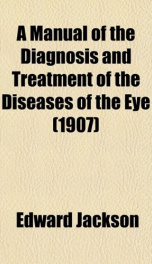a manual of the diagnosis and treatment of the diseases of the eye

Purchase of this book includes free trial access to www.million-books.com where you can read more than a million books for free. This is an OCR edition with typos. Excerpt from book: the opening. If the patient be allowed to look away from the opening, so that the impression is made upon some portion of the retina other than that affected (the macula), the color might be correctly named, although at the fixation point the color blindness were complete. Ring scototna is a form in which the center of the field of vision and the periphery remain normal, or less impaired than a ring-like area surrounding the center of the field. It may possibly be due to a lesion affecting a special portion of the optic nerves or tracts, but generally it is caused by disease in the corresponding portions of the choroid and retina. Most frequently, scotomas are single, or arranged without symmetry ; they may be permanent or quite transient. The latter will be referred to in connection with transient impairment of vision. Narrowing of the field of vision is the most significant symptom of atrophy of the optic nerve and certain allied affections. It is ascertained by testing the field of vision with the hand or with a perimeter. Symmetrical narrowing points to primary atrophy of the optic nerve or to the effects of certain poisons. [See Quinin Blindness, Chapter XIII.] It is apt to affect the field of vision for colors before there is any notable change in the field for form. Irregular narrowing of the field, which may also affect the field for colors more than the field for form, is indicative of secondary optic atrophy, or injury to the tracts as by glaucoma, optic neuritis, etc. Inconstant impairment of vision after the eyes have for some time been used for close work, occurring particularly in the latter part of the day, or when the eyes are used by artificial light in the evening, is caused by the sudden relaxation of the accommodation, after the ciliary muscle has been...
Info about the book
Author:
Series:
Unknown
ISBN:
0071700552
Rating:
2.5/5 (1)Your rating:
0/5
Languge:
English
Users who have this book
Users who want this book
What readers are saying
What do you think? Write your own comment on this book!
write a commentGenre
if you like a manual of the diagnosis and treatment of the diseases of the eye try:
Do you want to read a book that interests you? It’s EASY!
Create an account and send a request for reading to other users on the Webpage of the book!


